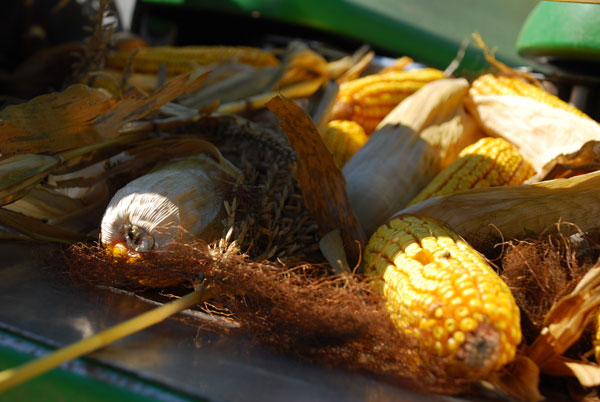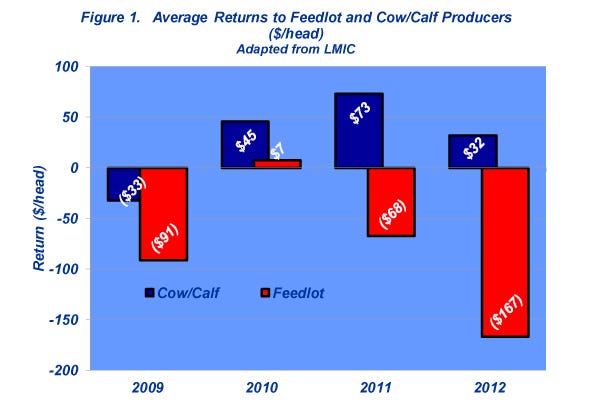EPA won’t make a final ruling on rolling back the renewable fuel standard until spring 2014, which complicates agricultural planning
December 4, 2013

November was a relatively quiet month from a market standpoint. Fed cattle saw steady trade in the low-$130s while Choice boxed beef danced around $200-205 throughout the month. That’s a fairly typical pattern going into the holidays. And from here, there likely won’t be any major surprises for the next 3-4 weeks, as the markets typically maintain the status quo through December.
In the meantime, there will be increasing focus upon what 2014 will bring for the markets. The primary question that remains out there revolves around producer appetite to expand the cowherd. Will 2014 witness a reversal in the long-term liquidation trend? Of course, that’s not a new question; it’s one that’s asked every year of late.
While the answer to that question partially depends on market signals, it also depends largely on any number of factors. That consideration inherently invokes the bigger question about the entire beef sector and how business might evolve and/or change in the coming year. That said, within a fairly tranquil market period, this is a good time to back up and assess some of the more important dynamics influencing the daily business of beef.
As I noted last month, December marks the four-year anniversary of the fed market’s sub-$80 trade. During that time, the market has increased over 60%. That’s the equivalent of an extra $50/cwt., or $650/head for every fed steer and heifer currently being marketed. Needless to say, that’s a substantial run in a short period.
Historically, higher markets are generally perceived as favorable throughout the industry. However, the wealth hasn’t been shared across the various sectors. This run has established the cow-calf producer as the primary benefactor (Figure 1).

Tight supplies have forced cattle feeders to ratchet up their respective pursuit of replacements. That has spelled higher feeder cattle prices, tighter feeding margins and the assumption of ever-increasing amounts of financial risk by cattle feeders just to maintain day-to-day operations.
Moreover, however, producers have NOT rebuilt the cowherd in response to higher prices. The decision-making process has become more complicated for cow-calf producers than simply reacting to the market.
Meanwhile, the entire supply chain from cow-calf producers to the feeding sector has been forced to fend off both higher and increasingly volatile feed prices. The challenge of sorting through the markets and trying to identify opportune times to lease grass, buy hay or purchase any type of feed input can prove both frustrating and unsettling. If nothing else, it certainly occupies a greater portion of time and attention.
That brings us around to the most recent news developments. While there are any number of factors of importance influencing the business going forward, perhaps the most important event of recent weeks reinforces the influence of regulation across a number of fronts. The Environmental Protection Agency’s (EPA) recent proposed rollback of the renewable fuel standard (RFS) by 3 billion gals. in 2014 possesses any number of important ramifications, not only for the beef industry, but for all of agriculture.
At the surface, the announcement is seemingly favorable. Conventional wisdom frames the rollback as a reduction in corn usage going forward; thus, feed prices will decline along the way. That’s an appropriate perspective, but it perhaps oversimplifies some of the broader implications stemming from the decision.
The kicker here is that EPA won’t make a final ruling until spring 2014; the first public hearing on the measure was held Dec. 5 in Washington, DC. A volume of 3 billion gals. of ethanol is roughly equivalent to 7.5 million acres of corn – assuming 150 bu./acre. (Figure 2 provides some historical perspective around corn, soybean, and wheat acreage.)

The timing means all of agriculture has to ponder various scenarios around potential usage, and battle for acres going into the heart of planting season. The shift will undoubtedly create a lot of market uncertainty from both a supply and a demand perspective. What that all means for land and equipment values remains to be seen.
As alluded above, the largest complication of the ethanol mandate hasn’t been management of the absolute price of corn; rather it’s been the need to manage additional volatility. Regardless of the absolute price level, it is amplification of price changes that really drives the need to manage working capital. That is, heightened volatility dictates the need for larger reserves to buffer against potential price spikes and/or margin calls.
Now, additional RFS ambiguity will likely create fallout for all of rural America. Not to mention that as we head into 2014, agriculture still doesn’t have a farm bill. Undoubtedly, the uncertainty influences risk appetite and long-term business planning for producers of all types.
All of this inherently summons broader economic principles, namely Hayek’s knowledge problem. The ability to know what will, or will not, shape incentives, preferences and/or future decision-making is unknowable. Conversely, any assumption of knowledge potentially limits the free market’s greatest asset – creativity.
In other words, large government programs, and/or sudden changes in them, inherently create winners or losers. However, it won’t necessarily be the right winners or losers from a creativity perspective that would have occurred in a free-market system.
Bringing this full circle, while the past four years has served to ramp up the overall level of revenue in the beef business, it’s also been one of many unknowns. In addition to ethanol, there’s any number of new dynamics out there that weren’t present prior to the financial crisis.
While it may seem redundant, it bears repeating month after month (because it’s so easy to get caught up with what’s right in front of us vs. stepping back and overlook the importance of taking the larger view): stay fully informed and maintain objective around all aspects of the business!
PRICE SUMMARY
| WEEK ENDING: |
| 29-Nov |
Slaughter Steers ($/cwt) | 132.66 |
Choice Cutout ($/cwt) | 202.04 |
Select Cutout ($/cwt) | 189.49 |
Hide and Offall ($/cwt) | 15.06 |
USDA Slaughter Weights (lb) | 1,339 |
USDA Steer Carcass Weights (lb) | 878 |
CME Feeder Cattle Index ($/cwt) | 165.88 |
Cow Cutout ($/cwt) | 155.80 |
Front-end Corn Futures Weekly Avg ($/bu) | 4.19 |
Cattle Harvest (000 head) | 555 |
Beef Production (million lb) | 444.7 |
You might also like:
2014 Will Be A Record Year For Calf Prices And Risk
65 Photos That Celebrate Cowgirls amp Cattlewomen
No USDA Price Data Market Seems To Say No Problem
About the Author(s)
You May Also Like





